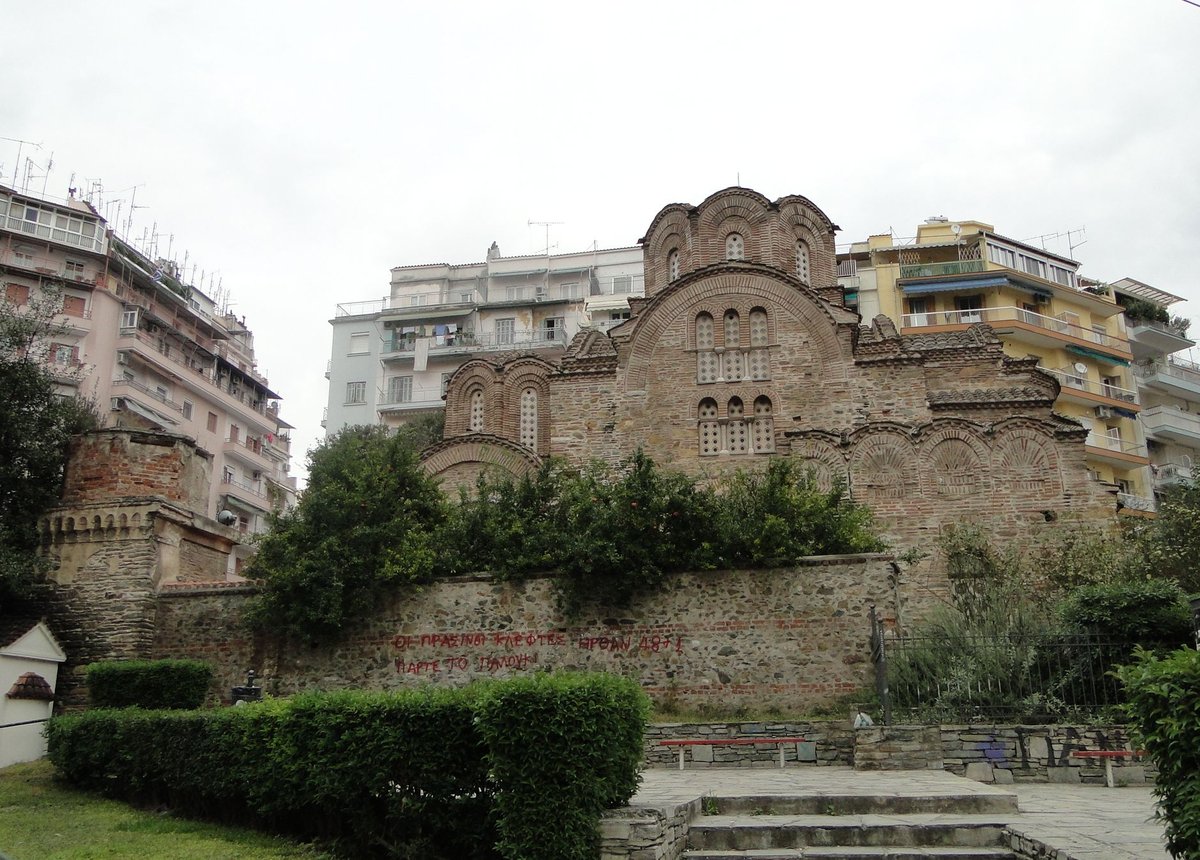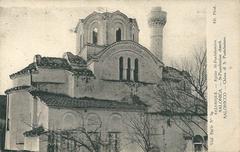
Church of Saint Panteleimon Thessaloniki: Visiting Hours, Tickets, and Historical Guide
Date: 14/06/2025
Introduction
The Church of Saint Panteleimon in Thessaloniki is a beacon of the city’s Byzantine heritage and a testament to its multicultural history. Built in the late 13th or early 14th century during the Palaiologan Renaissance, this monument reflects the artistic and spiritual vitality of its era. Its layered history—transitioning from a Byzantine Orthodox church to an Ottoman mosque (Ishakiye Camii) and then restored to Christian worship—mirrors Thessaloniki’s evolving spiritual and cultural landscape. As part of the UNESCO World Heritage listing for Thessaloniki’s Paleochristian and Byzantine monuments, it is celebrated for its historical, architectural, and religious significance.
Visitors can expect to explore impressive Byzantine architecture, surviving fresco and mosaic fragments, and elements from its Ottoman transformation, such as the minaret base. The church stands not only as a place of worship but also as a crucial link to Thessaloniki’s rich past, positioned conveniently near other major historical sites including the Rotunda and the Arch of Galerius. Digital resources and local tours further enrich the visitor experience, offering deeper historical insight and practical guidance (Spotting History, UNESCO, Greeka).
Table of Contents
- Introduction
- Historical Context and Religious Significance
- Architectural and Artistic Features
- Transformation During Ottoman Rule and Restoration
- Visiting Information
- Preservation, Management, and Community Engagement
- Cultural and Educational Impact
- Practical Tips for Visitors
- Frequently Asked Questions (FAQ)
- Conclusion
Historical Context and Religious Significance
Built during the Palaiologan Renaissance—a period of artistic revival within Byzantium—the Church of Saint Panteleimon is one of Thessaloniki’s significant late Byzantine monuments. It is widely believed to have initially served as the katholikon (main church) of the Monastery of the Virgin Peribleptos, founded by Metropolitan Jacob (Iakovos), who became a monk named Isaac (Spotting History, The Byzantine Legacy). The church’s current dedication to Saint Panteleimon, a Christian healer and martyr, likely dates to the post-Ottoman period, reflecting its continued religious importance.
Throughout its history, the church has been a center for religious life, scholarship, and artistic production in Thessaloniki. Its transformation into a mosque after the Ottoman conquest and subsequent restoration to Christian worship in the 20th century highlight the city’s multicultural identity and resilience (Saloniki Guide).
Architectural and Artistic Features
Cross-in-Square Plan and Structural Details
The church is a distinguished example of the cross-in-square architectural style, with a central dome supported by four columns. The main nave is flanked by side aisles and a narthex. Although the original ambulatory no longer survives, two side chapels remain intact, adding spatial complexity (Thessaloniki Tourism).
The exterior displays cloisonné masonry—alternating brick and stone layers—characteristic of the Palaiologan era. Blind arcades, pilasters, and decorative ceramic elements create visually striking facades.
Domes, Vaults, and Light
The central dome, constructed with brick and supported by pendentives, is pierced with windows, creating a luminous interior. Smaller domes and barrel vaults over the side aisles and narthex enhance the roofline and spatial dynamics (Byzantine Studies).
Frescoes, Mosaics, and Iconography
Although much of the original fresco program was lost or damaged, surviving fragments reveal scenes from the New Testament and portraits of saints, painted in the expressive Palaiologan style. Notably, a fresco of Agios Iakovos Adelfotheos (Saint James) is found in the diaconicon, possibly honoring the founder, Metropolitan Jacob (Saloniki Guide). Mosaic remnants in the sanctuary and ornamental marble revetments further illustrate the church’s artistic richness (Museum of Byzantine Culture).
Transformation During Ottoman Rule and Restoration
Ottoman Modifications
After Thessaloniki’s conquest in 1430, the church was converted into the Ishakiye Camii mosque. A minaret and marble ablution fountain were added, and Christian images were plastered over. The name “Ishakiye” may honor either the founder Isaac or the Ottoman judge Ishak Çelebi (Spotting History).
Restoration and Conservation
Following the city’s liberation in 1912, the building was restored to Christian worship. Extensive conservation efforts focused on stabilizing the structure, uncovering surviving frescoes, and protecting the monument’s historical integrity. The church’s inclusion in the UNESCO World Heritage list in 1988 ensures ongoing international attention and preservation (UNESCO).
Visiting Information
Hours and Admission
- Visiting Hours: Generally open Tuesday to Sunday, 8:00 AM–3:00 PM. Closed Mondays and some public holidays. Hours may vary during festivals or special services (Greeka).
- Admission: Free of charge; donations are appreciated for conservation.
- Tickets: For other UNESCO monuments in Thessaloniki, a combined ticket costs approximately €6–8 for adults.
Accessibility
The church is mostly accessible, though some uneven flooring and steps may present challenges for visitors with limited mobility. Staff assistance is available upon request.
Guided Tours and Visitor Experience
Guided tours, often offered by local agencies, provide deeper historical and architectural context. Informational plaques in Greek and English are present on-site. Digital resources and mobile apps like Audiala offer self-guided experiences (Welcome Greece Travel Guide).
- Photography: Non-flash photography is generally allowed; flash is discouraged to protect artworks.
- Visitor etiquette: Modest attire and respectful behavior are required, especially during services.
Nearby Attractions
The Church of Saint Panteleimon is centrally located, close to Thessaloniki’s major historic sites:
- The Rotunda: A massive round building originally built as a mausoleum and later converted to church and mosque.
- Arch of Galerius: A triumphal arch from the early 4th century.
- Church of Hagios Demetrios: The city’s patron saint’s basilica.
- Byzantine Walls: Offering panoramic views of Thessaloniki.
Interactive maps and virtual tours are available online and at local tourist centers (Thessaloniki Tourism).
Preservation, Management, and Community Engagement
The church is managed by the Greek Ministry of Culture and the Ephorate of Antiquities of Thessaloniki City. Restoration projects have stabilized the building and preserved its unique blend of Byzantine and Ottoman features. Recognition by Europa Nostra highlights exemplary conservation efforts (UNESCO).
Community events, especially the feast day of Saint Panteleimon on July 27, feature religious services and gatherings, reinforcing the church’s role as a living monument.
Cultural and Educational Impact
The Church of Saint Panteleimon is an important educational resource for scholars and students, influencing ecclesiastical architecture across the Balkans and Eastern Mediterranean. Ongoing educational initiatives and public programs deepen engagement with this world heritage site (Thessaloniki Tourism).
Practical Tips for Visitors
- Best time to visit: Early mornings or late afternoons for a quieter experience.
- Dress code: Modest, in line with Orthodox customs.
- Amenities: Cafés and shops are nearby.
- Safety: Thessaloniki is generally safe; standard travel precautions apply.
- Events: Check local listings for festivals or special services.
Frequently Asked Questions (FAQ)
Q: What are the Church of Saint Panteleimon’s visiting hours?
A: Typically Tuesday–Sunday, 8:00 AM–3:00 PM; closed on Mondays. Hours may vary.
Q: Is there an entrance fee?
A: Admission is free; donations support preservation.
Q: Are guided tours available?
A: Yes, through local operators and city tours. On-site information and digital guides are also available.
Q: Is the church accessible for visitors with disabilities?
A: Mostly accessible; some uneven surfaces may require assistance.
Q: Is photography allowed?
A: Yes, non-flash photography is permitted; flash and tripods are discouraged.
Q: What special events are held at the church?
A: The feast day of Saint Panteleimon (July 27) features religious celebrations.
Visuals and Resources

Alt text: Exterior view of the Church of Saint Panteleimon in Thessaloniki, featuring Byzantine brickwork and dome.
For more images and virtual tours, explore resources on Greeka and official tourism websites.
Conclusion
The Church of Saint Panteleimon stands as a vital link to Thessaloniki’s Byzantine past and its multicultural present. Its architectural elegance and historical depth offer an enriching experience for all visitors. Whether approached as a spiritual sanctuary, architectural marvel, or historical archive, this monument invites reflection and appreciation.
Plan your visit by checking the latest hours and events. Use digital guides like Audiala for an enhanced experience, and explore nearby UNESCO-listed sites to fully immerse yourself in Thessaloniki’s heritage.
Download the Audiala app for audio tours and interactive guides, and share your experience on social media with #ThessalonikiHeritage.
References and Official Sources
- Church of Saint Panteleimon, 2025, Spotting History (https://www.spottinghistory.com/view/10550/church-of-saint-panteleimon/)
- Paleochristian and Byzantine Monuments of Thessaloniki, UNESCO World Heritage Centre (https://whc.unesco.org/en/list/456/)
- Church of Saint Panteleimon Thessaloniki, 2025, Greeka (https://www.greeka.com/macedonia/thessaloniki/sightseeing/agios-panteleimon-church/)
- Byzantine Monuments of Thessaloniki, Thessaloniki Tourism (https://www.thessalonikitourism.gr/index.php/en/component/k2/item/77-church-of-agios-panteleimon)
- Church of Saint Panteleimon Thessaloniki, 2025, The Byzantine Legacy (https://www.thebyzantinelegacy.com/panteleimon-thessaloniki)
- Welcome Greece Travel Guide, 2025 (https://www.welcome-greece.gr/travel-guide-of-thessaloniki/)
- Saloniki Guide, 2025 (https://saloniki.guide/en/Attraction-Church_of_Agios_Panteleimon-p368-r189473-Thessaloniki)
- Byzantine Studies, 2025 (https://www.byzantium.gr/monuments/saint-panteleimon-thessaloniki/)




























